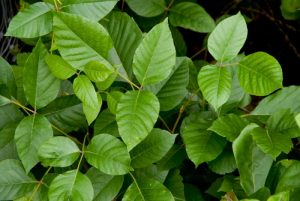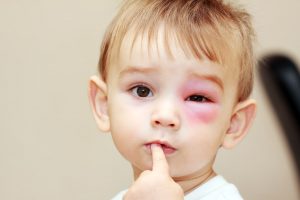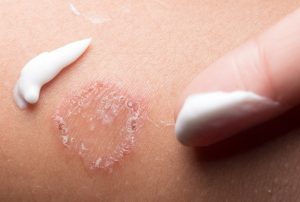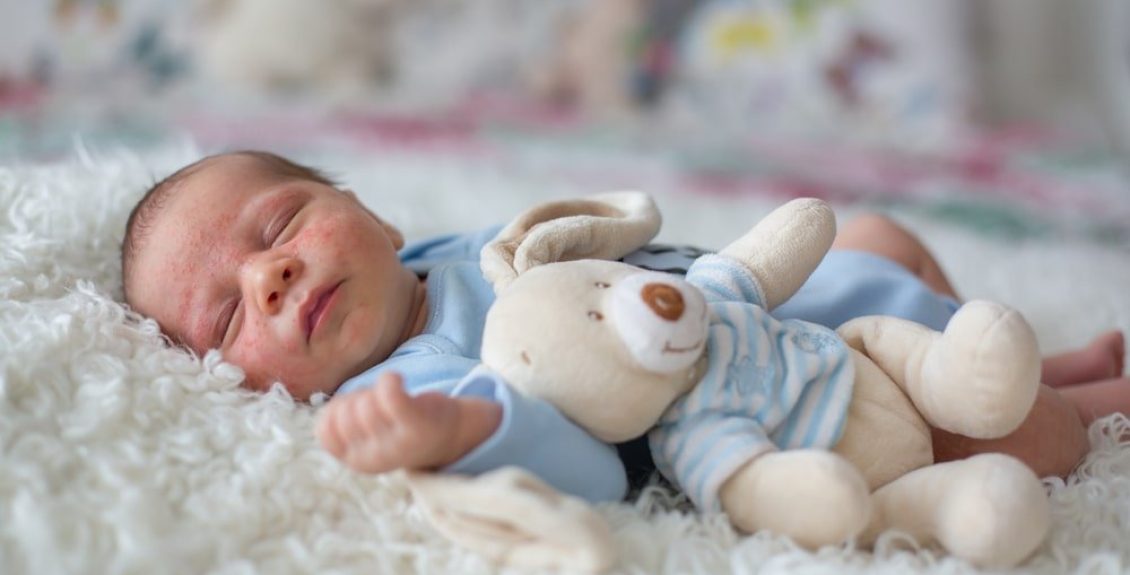Chances are your kids are going to get a rash from time to time. It is a pretty common occurrence during childhood. They might itch or hurt. A kids rash might just go away or they might need treatment. We know that it is not a good feeling when your child is suffering and you don’t know what to do.
That’s why we work so hard to make sure you have peace of mind with any issues that come up with your kids rash. And that’s why we are writing this article about rashes. We get a lot of calls and questions about rashes so we hope this gives you the information you are looking for. If not, please don’t hesitate to give us a call so we can help!
If your child has a rash, it’s probably on this list of common skin rashes.
Heat Rash
What is it? Heat rash happens when sweat gland pores get blocked so the perspiration cannot escape. It is more common for babies and young children. You’ll see areas of small reddish bumps or blisters. These usually appear in places like the neck, armpits, and thighs.
What should you do? The best thing to do is to keep your child cool and dry. Don’t apply skin ointment. Keep an eye on potential hot spots that get wet with sweat, urine, or drool. Wash those areas and pat them dry.
Poison Ivy
 What is it? Certain plants — such as poison ivy — cause an itchy, burning reaction on the skin. There will be redness, swelling, and blisters.
What is it? Certain plants — such as poison ivy — cause an itchy, burning reaction on the skin. There will be redness, swelling, and blisters.
What should you do? Wash everything they were wearing at the time of exposure (including shoes) to the plant in soap and water. Wash the skin that was exposed with soap and water for 10 minutes. It is a good idea to trim their fingernails too so they are less likely to scratch the area and spread the rash. Calamine lotion can help with the itchiness and 1% hydrocortisone cream helps with inflammation. Come see us if the rash isn’t getting better, is on their face or groin, or appears to be infected.
Eczema
What is it? This is a chronic condition with patches of dry and scaly red skin. It appears more often during the winter when there isn’t much moisture in the air. Sweating, overheating, and chlorine can also lead to an outbreak.
What should you do? Keep the area moist with a cream or ointment. Make sure the area is well-dried after a swim or shower and then apply the moisturizer. Wear clothing made with a soft fabric like cotton. Use detergent with no dye or perfume.
Bites/Stings
 What is it? Many kids are afraid of getting stung by a bee (or other insects). For most, it is just a small prick that breaks the skin and hurts for a short time. But for others, it can cause a severe reaction. Signs include a rash, hives, and airway swelling that can be life-threatening.
What is it? Many kids are afraid of getting stung by a bee (or other insects). For most, it is just a small prick that breaks the skin and hurts for a short time. But for others, it can cause a severe reaction. Signs include a rash, hives, and airway swelling that can be life-threatening.
What should you do? Things like insect repellent or keeping skin covered will help prevent stings and bites. But when your kid does get stung, you can soothe them by making sure the skin is clean with rubbing alcohol or first aid ointment. Take a close look to ensure there is no stinger or anything left in their skin. Apply cold to the area for 10 minutes if there is any swelling.
Impetigo
What is it? This bacterial skin infection typically happens when the weather is hot and humid. You’ll see a rash with fluid-filled blisters or that is oozing with honey-crusted scabs around it.
What should you do? Use soap and water to clean the area. Keep it covered so it doesn’t spread, but do it loosely so air can get in and help the healing process. Make sure they avoid scratching it which will also cause it to spread. This may require a prescription for topical antibiotics or even a skin culture test to determine the cause.
Swimmer’s Itch
What is it? It’s called swimmer’s itch because it shows up after playing in a lake or other body of water. This rash comes from parasites that reside in the warmer, shallow water along the shore. The parasites create tiny red spots on the skin by burrowing into it. There may be blisters too.
What should you do? Take care when choosing a place to swim. Avoid areas where snails and birds hang out and you should avoid these parasites. If you do play in the water, make sure to shower off or briskly towel off immediately. This should get any parasites off of the skin before they begin to burrow (they do this when the skin starts to dry out). Treatment you can try includes a cool compress, Epsom salt, oatmeal bath, and baking soda paste.
Hot Tub Rash
What is it? As the name suggests, this type of rash comes from bacteria in dirty pools and hot tubs. The bacteria gets into the hair follicles on the skin. The area can be infected and inflamed and may have blisters that have pus inside. It normally starts in 12-48 hours after being in a hot tub.
What should you do? Only use clean pools. Keep the kids out of hot tubs. The good news is that this rash should clear up on its own. But you can also use a warm compress or over-the-counter anti-itch cream.
Sweaty Sock Syndrome
What is it? This is a condition called Juvenile Plantar Dermatosis. It is a red rash on a child’s foot that may have peeling, cracking, or scaly skin. It is caused when their feet get wet and then dry quickly — over and over.
What should you do? Have your kids wear breathable footwear so their feet don’t get so hot and sweaty. Thick, absorbent socks can also help. Moisturizing ointment should help if it is applied when they get out of the water or remove their shoes.
Ringworm
 What is it? Ringworm is an infection that comes from a fungus that lives in warm, damp places — like athlete’s foot or jock itch. It frequently appears on a child’s scalp. The rash forms in round/oval spots. They are smooth in the center with red scales around the edges. This rash can spread from person to person quickly among athletes.
What is it? Ringworm is an infection that comes from a fungus that lives in warm, damp places — like athlete’s foot or jock itch. It frequently appears on a child’s scalp. The rash forms in round/oval spots. They are smooth in the center with red scales around the edges. This rash can spread from person to person quickly among athletes.
What should you do? Everything you can to make sure it doesn’t spread. Make sure anyone with symptoms is treated. Make sure things like combs and brushes are not shared or are properly disinfected. This rash can be treated with an over-the-counter cream but may require a prescription – especially if it is in the scalp.
Hand, Foot & Mouth Disease
What is it? This is a viral illness that is more common in the summer and early fall and affects younger children. Symptoms are similar to a cold — fever, sore throat, runny nose. The difference is the rash (with tiny blisters) that will show up in the mouth, on fingers or hands, the soles of their feet, and on their butt.
What should you do? The symptoms usually go away within a week so keep an eye on them. Come see us if their fever goes longer than three days or they will not drink anything. It is important for them to stay hydrated. You can use acetaminophen or ibuprofen or liquid mouth-soothing remedies to help with the pain. When their fever is gone and they feel better, and there are no open blisters, you no longer need to keep them home.
Just 4 Kids Urgent Care
Your child may wind up with an uncomfortable kids rash at any time, but especially during the summertime when they have a lot of exposed skin. We hope this guide helps you identify and manage any rash that your child may have. If you have any questions or need help, please feel free to give us a call or come and see us. We are here to help you take care of your child and have peace of mind in the process. Take a look at these additional resources for help with your kids.
